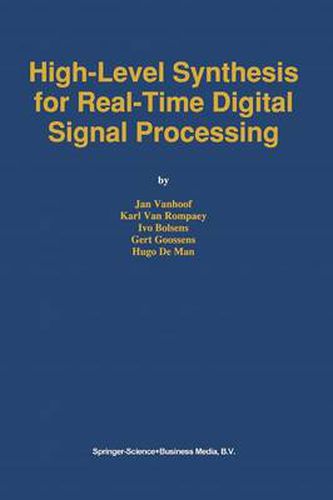Readings Newsletter
Become a Readings Member to make your shopping experience even easier.
Sign in or sign up for free!
You’re not far away from qualifying for FREE standard shipping within Australia
You’ve qualified for FREE standard shipping within Australia
The cart is loading…






This title is printed to order. This book may have been self-published. If so, we cannot guarantee the quality of the content. In the main most books will have gone through the editing process however some may not. We therefore suggest that you be aware of this before ordering this book. If in doubt check either the author or publisher’s details as we are unable to accept any returns unless they are faulty. Please contact us if you have any questions.
High-Level Synthesis for Real-Time Digital Signal Processing is a comprehensive reference work for researchers and practicing ASIC design engineers. It focuses on methods for compiling complex, low to medium throughput DSP system, and on the implementation of these methods in the CATHEDRAL-II compiler. The emergence of independent silicon foundries, the reduced price of silicon real estate and the shortened processing turn-around time bring silicon technology within reach of system houses. Even for low volumes, digital systems on application-specific integrated circuits (ASICs) are becoming an economically meaningful alternative for traditional boards with analogue and digital commodity chips. ASICs cover the application region where inefficiencies inherent to general-purpose components cannot be tolerated. However, full-custom handcrafted ASIC design is often not affordable in this competitive market. Long design times, a high development cost for a low production volume, the lack of silicon designers and the lack of suited design facilities are inherent difficulties to manual full-custom chip design. To overcome these drawbacks, complex systems have to be integrated in ASICs much faster and without losing too much efficiency in silicon area and operation speed compared to handcrafted chips. The gap between system design and silicon design can only be bridged by new design (CAD). The idea of a silicon compiler, translating a behavioural system specification directly into silicon, was born from the awareness that the ability to fabricate chips is indeed outrunning the ability to design them. At this moment, CAD is one order of magnitude behind schedule. Conceptual CAD is the keyword to mastering the design complexity in ASIC design and the topic of this book.
$9.00 standard shipping within Australia
FREE standard shipping within Australia for orders over $100.00
Express & International shipping calculated at checkout
This title is printed to order. This book may have been self-published. If so, we cannot guarantee the quality of the content. In the main most books will have gone through the editing process however some may not. We therefore suggest that you be aware of this before ordering this book. If in doubt check either the author or publisher’s details as we are unable to accept any returns unless they are faulty. Please contact us if you have any questions.
High-Level Synthesis for Real-Time Digital Signal Processing is a comprehensive reference work for researchers and practicing ASIC design engineers. It focuses on methods for compiling complex, low to medium throughput DSP system, and on the implementation of these methods in the CATHEDRAL-II compiler. The emergence of independent silicon foundries, the reduced price of silicon real estate and the shortened processing turn-around time bring silicon technology within reach of system houses. Even for low volumes, digital systems on application-specific integrated circuits (ASICs) are becoming an economically meaningful alternative for traditional boards with analogue and digital commodity chips. ASICs cover the application region where inefficiencies inherent to general-purpose components cannot be tolerated. However, full-custom handcrafted ASIC design is often not affordable in this competitive market. Long design times, a high development cost for a low production volume, the lack of silicon designers and the lack of suited design facilities are inherent difficulties to manual full-custom chip design. To overcome these drawbacks, complex systems have to be integrated in ASICs much faster and without losing too much efficiency in silicon area and operation speed compared to handcrafted chips. The gap between system design and silicon design can only be bridged by new design (CAD). The idea of a silicon compiler, translating a behavioural system specification directly into silicon, was born from the awareness that the ability to fabricate chips is indeed outrunning the ability to design them. At this moment, CAD is one order of magnitude behind schedule. Conceptual CAD is the keyword to mastering the design complexity in ASIC design and the topic of this book.